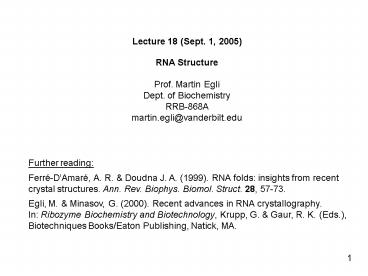Further reading: - PowerPoint PPT Presentation
1 / 21
Title: Further reading:
1
Lecture 18 (Sept. 1, 2005) RNA Structure Prof.
Martin Egli Dept. of Biochemistry RRB-868A martin.
egli_at_vanderbilt.edu
Further reading Ferré-DAmaré, A. R. Doudna
J. A. (1999). RNA folds insights from
recent crystal structures. Ann. Rev. Biophys.
Biomol. Struct. 28, 57-73. Egli, M. Minasov,
G. (2000). Recent advances in RNA
crystallography. In Ribozyme Biochemistry and
Biotechnology, Krupp, G. Gaur, R. K. (Eds.),
Biotechniques Books/Eaton Publishing, Natick,
MA.
1
2
(A) The RNA 2-hydroxyl group shifts the sugar
conformational equili- brium toward the C3-endo
pucker. (B) RNA duplexes adopt exclusively the
A-type conformation and the 2-OH groups rim the
minor groove.
B
A
It is probably impossible to build this
structure with a ribose sugar in place of the
deoxyribose, as the extra oxygen would make too
close a van der Waals contact.
- Watson Crick (1953)
2
3
O2
3
4
The DNA minor groove is drier than the RNA minor
groove the extensive hydration of RNA leads to
an enthalpic stabilization of RNA relative to DNA
(next page)
A-DNA A-RNA
(The views are into the minor groove water
molecules are cyan spheres)
4
5
Thermal denaturation (UV melting experiments) of
DNAs as a function of base composition (per
cent GC) for three species of bacteria (a)
Pneumococcus (38 per cent GC) (b) E. coli (52
per cent GC) (c) M. phlei (66 per cent GC)
5
6
Classification of RNA molecules
messenger in biological information transfer
(mRNA) adaptor molecule in protein synthesis
(tRNA) major constituent of the ribosome
(rRNA) plays major roles in interaction with a
multitude of proteins (RNPs) other protein-RNA
assemblies (examples spliceosome, telomerase,
signal recognition particle, etc.) miRNAs and
siRNAs direct degradation of RNAs in vivo
(RNAi) ribozymes (RNA enzymes) RNA aptamers
(have an aptitude for substrates in vitro
selected)
6
7
What does RNA structure mean?
- Primary structure sequence 5-GCCUUAGACG
- Secondary structure result of two or more
adjacent canonical -
(Watson-Crick) or non-canonical base - pairs
i.e. an A-form duplex. Note There - are
lots of non-canonical base pairs in RNA - (if
you can draw it, it probably exists). - Tertiary structure lone base pairs,
non-canonical interactions -
involving base triples, quadruples, etc. - Motifs,
such as tetraloop-tetraloop receptor, - U-turn,
C-turn, S-turn, A-platform, minor - groove
triplex. Importance of long-range -
interactions in RNA differs fundamentally - from
the situation in proteins.
7
8
Non-canonical pairing modes in RNA
are ubiquitous, and are related to the
single-stranded nature of RNA and a diverse array
of functions. See also the Non Canonical
Base-Pair Database at http//prion.bchs.uh.edu/bp_
type/ and U. Nagaswamy, N. Voss, Z. Zhang G. E.
Fox. Nucleic Acids Res. 28, 375-376 (2000).
8
9
RNA modifications
Both the structural diversity and extent of
posttranscriptional modification in RNA is
remarkable, with 96 different nucleosides
presently known in all types of RNA. Natural,
chemically modified nucleosides serve an array
of functional roles, i.e. control of base pairing
mode, chemical stability change in the pKa of a
nucleobase and protein recognition. See also the
RNA Modification Database at http//medstat.med.ut
ah.edu/RNAmods/ and P.A. Limbach, P.F. Crain
J.A. McCloskey. Nucleic Acids Res. 22, 2183-2196
(1994).
8
10
RNA secondary structural elements
hairpin loop
internal loop
stem
bulges and mismatches
junction
single strand
9
11
RNA tertiary structure
Tertiary interactions generally comprise 1) two
helices 2) two unpaired regions 3) one unpaired
region and a double-stranded helix ?
pseudoknotting
10
12
Lateral contacts between the minor grooves of RNA
helices ribose zippers
Interdigitated 2-hydroxyl groups make contacts
to 2- hydroxyl groups of adjacent helices as
well as to nucleo- bases (hydrogen bonds are
dashed lines).
11
13
Secondary tertiary structure of the hammerhead
ribozyme
U turn
U turn
12
14
GNRA (and UUCG) tetraloops are particularly
stable and resemble the U-turn
GNRA
U-turn
(Superposition)
13
15
Secondary tertiary structure of the P4-P6
domain of group I intron
A platform
14
16
(A) The adenosine platform in the tetraloop
receptor of the Tetrahymena thermophila group I
intron and (B) tetraloop-tetraloop receptor
interaction
A
B
16
1
17
The cross-strand adenosine stack in the loop E
of E. coli 5S rRNA The arrow marks the kink in
the backbone of the G72-A73 strand in the region
of the O5-C5 and C5-C4 bonds
17
18
The corkscrew motif (A-rich bulge) in the group
I intron P4-P6 domain is unusual in that
nucleobases are arranged on the outside and
phosphates are on the inside, sequestered by
coordinating magnesium ions (in gold)
The motif contributes to the stabilization of
the 180 turn between P5 and P5a.
18
19
Secondary tertiary structure of the hepatitis
delta virus ribozyme
19
20
Overall structure of the ricin/sarcin loop (SRL)
region of 28S rRNA
S-turn
20
21
Secondary tertiary structure of Phe transfer
RNA (tRNAPhe)
Please see also kinemage animation, chapter 7
(BT)
21































